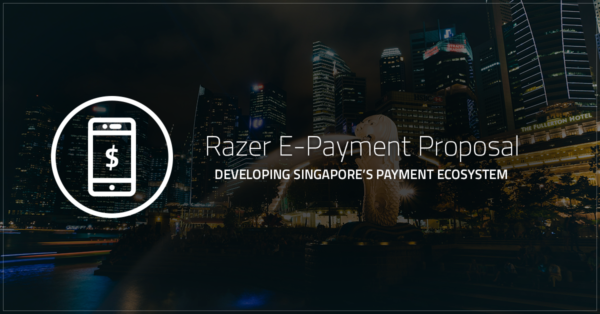
Razer head honcho Tan Min Liang is a confident guy. The gaming company he founded has, over the years, gained a cult following stronger than Apple’s and grown into a billion-dollar behemoth.
So when he recently exchanged tweets with Prime Minister Lee Hsien Loong about coming up with a new e-payment system for Singapore, you wouldn’t bet against him delivering a proposal, as he did today.
Though little is known to the public now, the proposal to the government calls for a cloud-based e-wallet that can be used on a phone app, stored-value card or chip.
Razer also promised S$10 million in seed money to get the project off the ground. It expects mass adoption in 18 months too.
If nothing else, this is the kind of kick up the backside needed to get the industry to sit up. It could shake off the inertia in banks and other financial institutions that are slow to act, or don’t want to act, because old practices die hard.
Don’t forget they get paid for services like topping up CashCards and charge “convenience fees” to consumers to go cashless. For merchants, accepting credit cards also means charges that cut into margins.
Yet, the problem lies not just with the current system. There are already numerous payment systems here – from contactless credit cards to mobile wallets from Samsung and Apple, to name a few.
And we just had PayNow, a nationwide system that lets people send funds to someone as if they are sending an SMS. You just need their IC number or phone number to wire money over.
So, is there a need for another system from Razer? Perhaps if it can unify a number of them to make things easy for users, that could gain it some traction. But it still faces the same challenge – getting users and merchants onboard.
If you visit a retail shop today, you already see so many terminals to handle various payment systems, from Nets to credit cards. Some also accept CashCard and ez-link cards, two other payment systems. Will adding another one solve the issue?
Tan is genuine in trying to find a way forward. He says it is alright if another system wins through, even if it’s not his company’s RazerPay.
In truth, Singapore has had cashless payment for many years. Yet, many issues have stopped the country from leading from the front.
Japan’s famed phone wallets have been used for years to pay for train rides and even ramen at the station. Similarly, in Hong Kong, the Octopus card has also been used widely for train rides and many other items.
Instead of one, Singapore has been divided by two systems – CashCard for drivers and ez-link for commuters. So entrenched is each that attempts at unifying them have always met with dismal results.
There has been a local standard, called CEPAS, that makes the two systems talk to one another, since 2009. It’s meant to make your CashCard and ez-link cards work interchangeably. It does so, most of the time.
Today, I can slot my ez-link card into my car’s in-vehicle unit and drive through a toll gantry without worry, but not all carparks support it. Some still require CashCards, possibly because they have not upgraded their systems.
That is just one reason why cashless can be a hair-pulling experience in Singapore. If the recent efforts at going cashless are going to have any chance of success, the first thing to do is ask why those of the past hadn’t worked.
And why are we forcing this issue now? Let’s not forget the technology has to fit the user, not the other way round.
China has been held up as a foil to Singapore, thanks to its embrace of mobile payment. There, you can pay for a buffet dinner by scanning a bar code with your phone app. You can transfer money, even electronic hongbao to a friend over the same app.
But these apps work because of unique local conditions. Credit cards were not common in the past, so mobile payment filled a gap in e-payment. For folks worried about counterfeit bills, the technology also assuaged a real fear.
In India, though credit cards have been around for decades, many shops do not want to spend money on swiping machines or the accompanying phone lines. When simpler, mobile payments came along, they flourished.
So, what’s Singapore’s problem? Is there one that requires a new payment system that current ones cannot handle? Or is this a case of a technology looking for a problem to solve?
Razer’s proposed system, when more details are out, may just shake things up. It could be a fresh start from an outsider, not one with vested interests. Or it could be really easy and sleek to use, like the company’s gaming mice.
Yet, I can’t help thinking of a story a colleague told me years ago, when he tried to pay a library fine for returning a book late.
Turning up with his dollar notes and coins, he was told that the library only accepted CashCard payment. Wasn’t his cash legal tender, he had wondered. Sorry, came the reply, the cashless way was the only way.
Lest we forget, the success of any cashless payment rests on its users. New technology or old, it is nothing if it does not make sense to people.







Well said and I can’t agree better with Alfred. Our national is definitely not short of e-payment solutions; neither are we behind the technology curve in launching it to the market. It is just far too many of them and too complicated.
How many times have you walked to a store with nets flashpay but cannot use it? What about another store with a prominent ezlink logo but you were unsure if your nets flashpay card can be used? CEPAS supposed to solve this and ensure seamless usage across POS terminals but how much work has the authority done to ensure Interoperability between systems in retail and carpark?
Taking the latter as an example, LTA manages a so called CEPAS “compliant” carpark list. In my opinion, it is not well administrated. When it says compliant, it is not necessary true. The reason is because there is a lack of certification effort to ensure it is compatible to a pre-set level of conformance.
In a layman world, when we see compliant, we would imagine the car park system will accept any CEPAS card in the car IU and work seamlessly, well it is not always true. There are many instances where you need to change your contactless cash card in the car IU to the regular chip base cash card to make it work, or tap your card at the carpark terminal. The fact of the matter is, who owns CEPAS and the communication protocol to IUs? Can’t they do a better job to make things work better?
I tend to disagree with Alfred on his comment on carpark system not upgraded. Because there are many new malls with carpark system not working well with the CEPAS standard. In my opinion, if there is a lack of effort to do compliance testing and guidance to carpark gantry manufacturers, how could you expect a property developer to make an informed decision on what system to buy?
I strongly believe by creating a robust framework around CEPAS (contactless, NFC) together with PayNow is a more realistic approach towards the problem. After all, we are not short of e-payment solutions on this island.